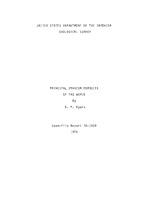The geology of the principal world uranium deposits that have identified uranium reserves and production, as described in published literature, is summarized briefly, including such features as type of deposit, host rock and age of host roc, age of mineralization, depositional environment, and mineralogy.
The deposits are located on four maps with the deposit grouped according to age of host rocks?Precambrian, Paleozoic, Mesozoic, and Cenozoic?and further subdivided into types of deposits and size categories. Types of deposits are penecordant sandstone, quartz-pebble conglomerate, vein and vein-type, marine black shale, phosphate deposits, coaly carbonaceous rocks, and pegmatic and alaskitic rocks.
The economically most significant deposits of uranium known in 1975 are in quartz-pebble conglomerates and sandstones, which together represented about 75 percent of the world?s total production.
The largest deposits occur in quartz-pebble conglomerate at the Elliot Lake-Blind River area, Canada (average grade 0.12 percent U3O8), and at the Witwatersrand basin area in the Republic of South Africa (average grade 0.025 percent U3O8), where uranium is produced principally as a byproduct or coproduct of gold mining; and in medium-grained sandstones in the Colorado Plateau, USA (average grade 0.2 percent U3O8). Other economically significant concentrations are vein, pegmatite or contact metamorphic types, containing smaller but relatively high-grade tonnages and representing about 20 percent of the world?s total production. At Vastergotland (Billingen) and Narke in Sweden, uranium has been recovered on a pilot-plant basis from black shale deposits having an uncommonly high grade for black shale of 0.03 percent U3O8. ?Recoverable reserves? in the near future (40 year period, lifetime of nuclear plants) is on the order of 50,000 metric tons U.
Over 50 percent of the world?s total uranium reserves is located on or near the trend of the iron deposits in the Precambrian iron formation, referred to as the ?iron band?.


